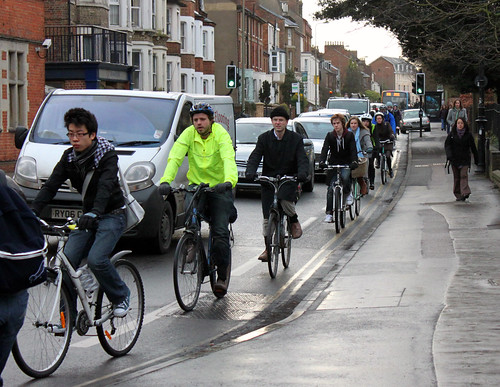Cycling plays a crucial role in the local transport system. It is environmentally sustainable, cheap and efficient, widely available and promotes health. Cycling facilities include:
CYCLE LANES - These are areas of carriageway designated and marked for use by pedal cycles. They can be either advisory or mandatory. Cycle lanes alert drivers to the presence of cyclists and give cyclists greater confidence. They can be introduced to help cyclists by-pass queuing traffic and lead cyclists to special facilities such as advanced stop lines at traffic signals. They are most useful where there are few side roads and no parking or loading requirements.

MANDATORY CYCLE LANES – These are marked with a continuous white line and are supported by a Traffic Regulation Order (TRO), which prohibit vehicles from driving or parking in the lane. Mandatory lanes must be discontinued at side road junctions but the use of a short length advisory lane may preserve continuity.

ADVISORY CYCLE LANES – These are marked with a broken white line and do not require a TRO. They can be continued across side road junctions. Both advisory and mandatory cycle lanes can be coloured to emphasise their presence. Cycle lanes are generally between 1.0m and 2.0m in width depending on flows and site characteristics although a minimum width of 1.5 meters is recommended. An additional 500mm “buffer” zone is recommended where a cycle lane passes alongside designated parking spaces.
CONTRA-FLOW CYCLE LANES - These are becoming more widely used as a cycle priority measure. They are mandatory cycle lanes which allow cyclists to travel against the prevailing flow of traffic in one-way streets, within the designated lane.
CONTRA-FLOW CYCLE STREETS - These are a relatively new innovation. They can be introduced in lightly trafficked roads where the site characteristics prevent the introduction of a formal contra-flow lane. they do not effect existing parking arrangements and are defined by signing and cycle markings at intervals
CYCLE PATHS – In some circumstances it may be considered unsafe to designate areas of carriageway as cycle lanes. Where pedestrian flows are relatively low it may be appropriate to provide a cycle way on the footway. It is recommended that footways are at least 3 meters wide if a cycle path is to be considered but, in practice they may be accommodated on narrower footways when flows and site characteristics permit. Cycle paths may be one or two-way. Cyclists and pedestrians may be segregated by a white line or some other feature or may share the full width of the footway. In either case complimentary advisory signing is normally provided.
CYCLE TRACKS - These are traffic-free, off-highway cycle routes normally shared with pedestrians. The Bristol to Bath Railway Path is a prime example of a successful cycle track. It forms a vital link in the National Cycle Network (NCN) and provides a high quality, safe pedestrian and cycle route, encouraging people of all ages and ability to walk and cycle, both for short and longer journeys, for leisure and commuting.
This information has been reproduced by kind permission of Bristol City Council
- Photos of cycle lanes
- Rules on using cycle lanes
- Sustrans - network of National Cycle Paths

No comments yet.